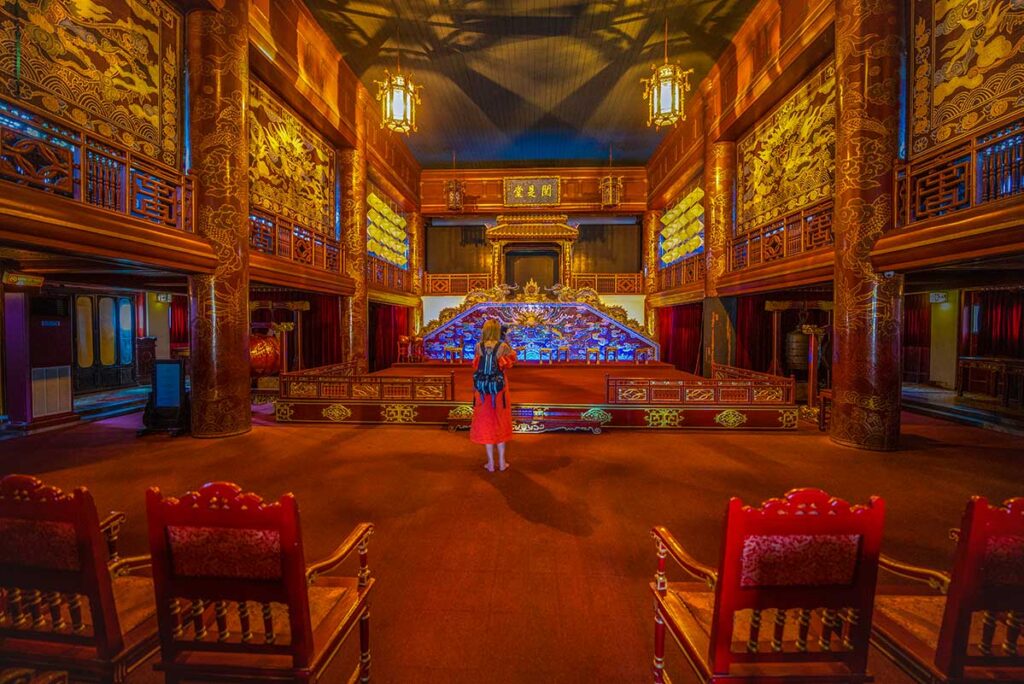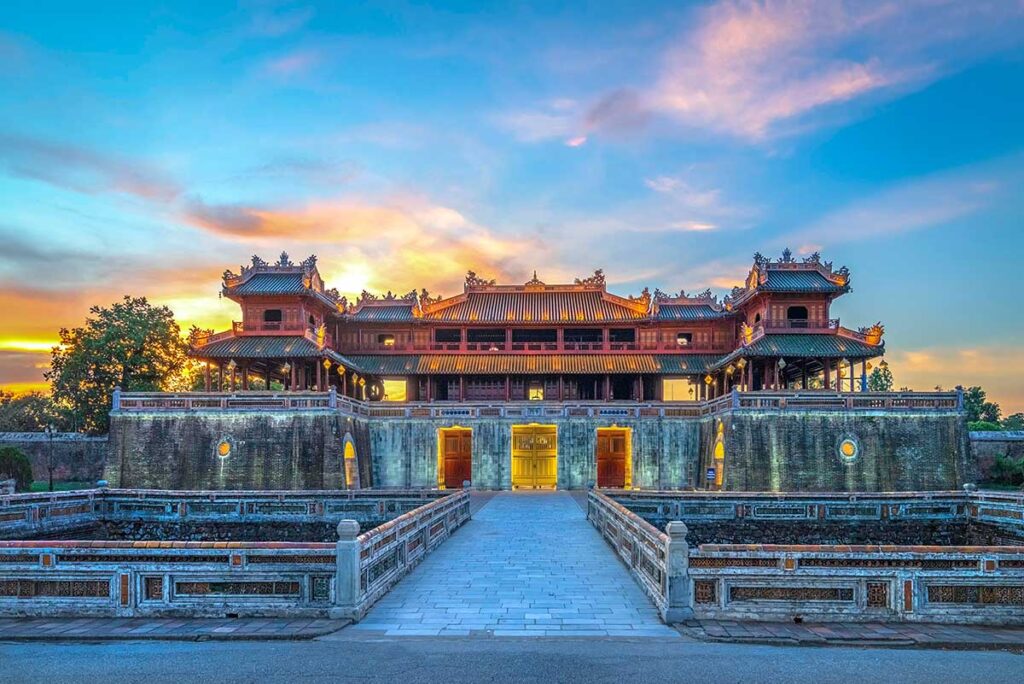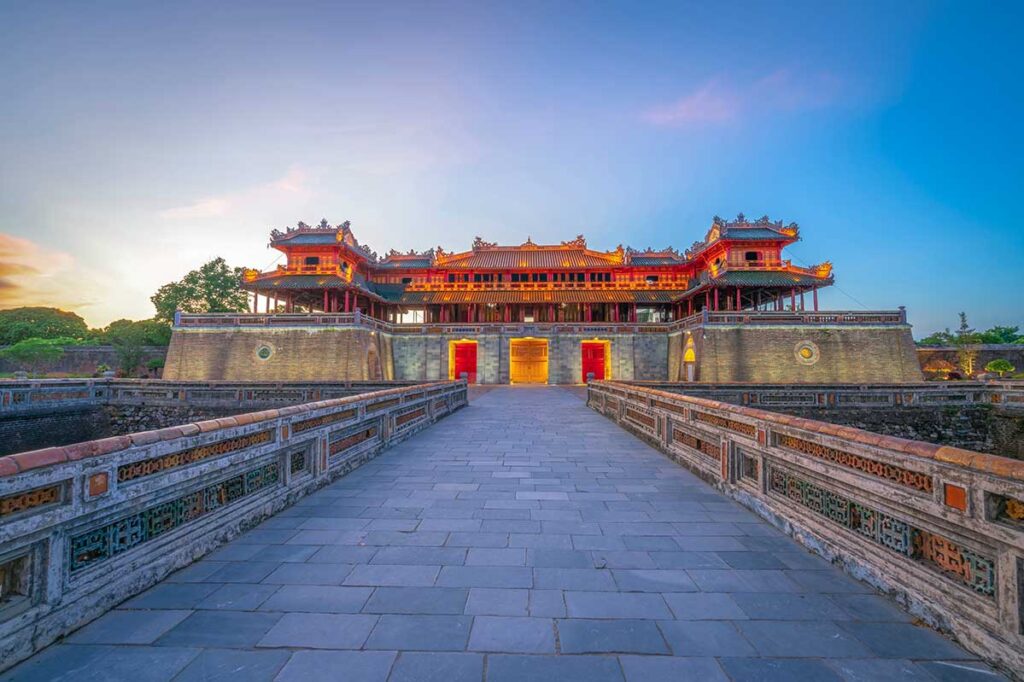What is the Hue Royal Theatre?
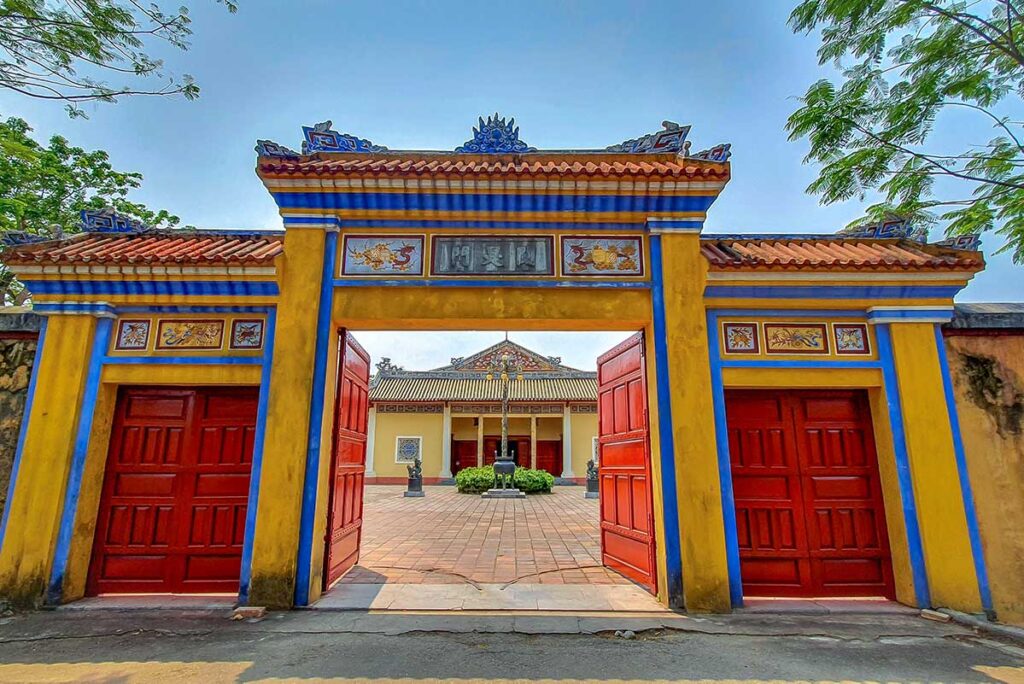
Hue Royal Theatre, also known as Duyet Thi Duong, was the main venue for court performances during the Nguyen dynasty. Built as a space where emperors, royal family members, mandarins, and honoured guests could enjoy refined entertainment, it showcased traditional art forms such as Nha Nhac (Hue Royal Court Music), classical Tuong theatre, and elegant royal dances. Located in the southeast corner of the former Forbidden Purple City, the theatre sits within walking distance of other key landmarks in the Imperial City, including Thai Binh Pavilion, Dien Tho Palace, and the To Mieu Temple Complex.
History of Hue Royal Theatre (Duyet Thi Duong)
Origins and construction
Duyet Thi Duong was commissioned by Emperor Minh Mang in 1826, built on the site of the earlier Thanh Phong Duong Theatre from 1805. It formed part of the southeast corner of the Forbidden Purple City and was designed as a dedicated space for imperial performances. The name “Duyet Thi Duong” roughly translates to “hall for viewing performances,” reflecting its ceremonial purpose.
Golden era
During its prime, the theatre hosted a wide range of royal entertainment. Nha Nhac (Hue Royal Court Music), Tuong (classical drama), and intricate royal dances were performed for the emperor, his family, high-ranking mandarins, and visiting envoys. It was also a venue for important ceremonial occasions, reinforcing court protocol and displaying the cultural refinement of the Nguyen dynasty to foreign guests.
Decline and repurposing
After the fall of the Nguyen dynasty in 1945, the theatre fell into neglect. Years of conflict and exposure to the elements caused severe damage to the building. In 1962, under the Republic of Vietnam, the site was repurposed as the teaching base for the Hue National School of Music (now Hue University of Arts). Many original features were altered or removed during this period, leaving little space for its original performance function.
Restoration and reopening
From 1995 to 2002, the Hue Monuments Conservation Center undertook a full restoration, aiming to revive the theatre’s traditional appearance while adapting it for modern use. Decorative details, seating arrangements, and the stage were carefully reconstructed. Duyet Thi Duong reopened in March 2003, once again hosting royal court performances and serving as an important cultural venue within the Imperial City.
Layout of the Imperial City
The Hue Royal Theatre is part of the larger complex of the former imperial capital, which was designed in a series of walled enclosures. Understanding this layout helps place the theatre in its historical and geographical context:
- Hue Citadel – The vast outer wall and moat system, enclosing administrative offices, residential areas, temples, and gardens.
- Hue Imperial City – The central area within the citadel, home to the emperor’s official buildings, shrines, and ceremonial spaces.
- Forbidden Purple City – The innermost enclosure, reserved exclusively for the emperor, his family, and select attendants.
The Hue Royal Theatre (Duyet Thi Duong) sits in the southeast corner of the Forbidden Purple City, close to other significant structures such as the former Royal Hospital and the Thuong Thien Department.
Highlights of visiting Duyet Thi Duong today
1. Exterior architecture
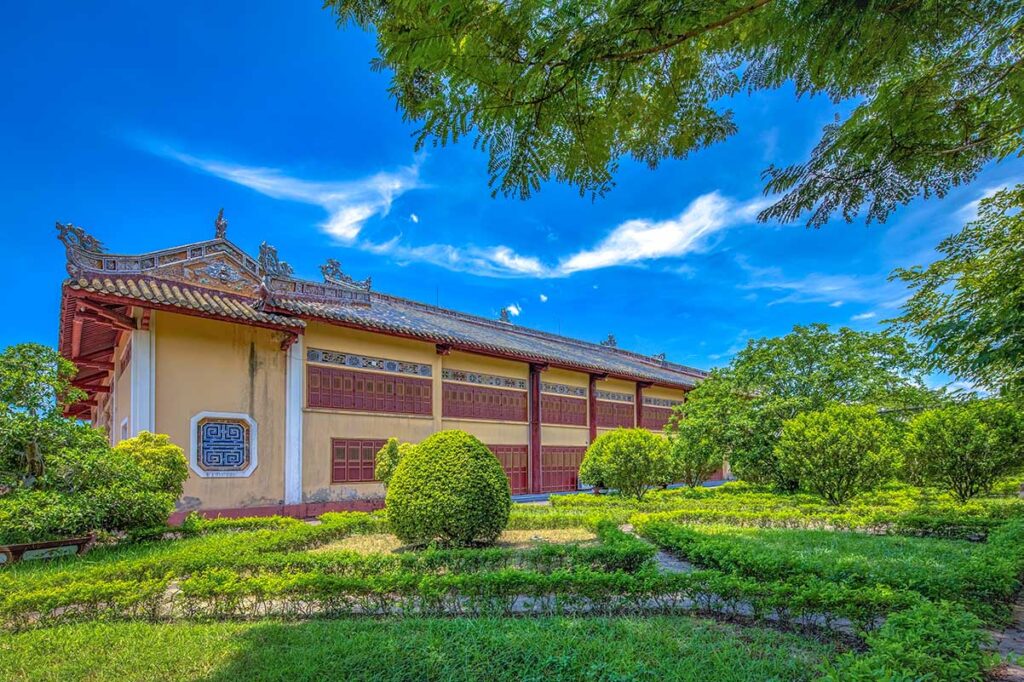
The theatre’s exterior reflects the elegance of Nguyen dynasty design, with a two-storey structure built from durable ironwood. Its gently curved roof is adorned with decorative motifs, including dragons and phoenixes, while lacquered details and symbolic patterns highlight its royal status.
2. Interior design
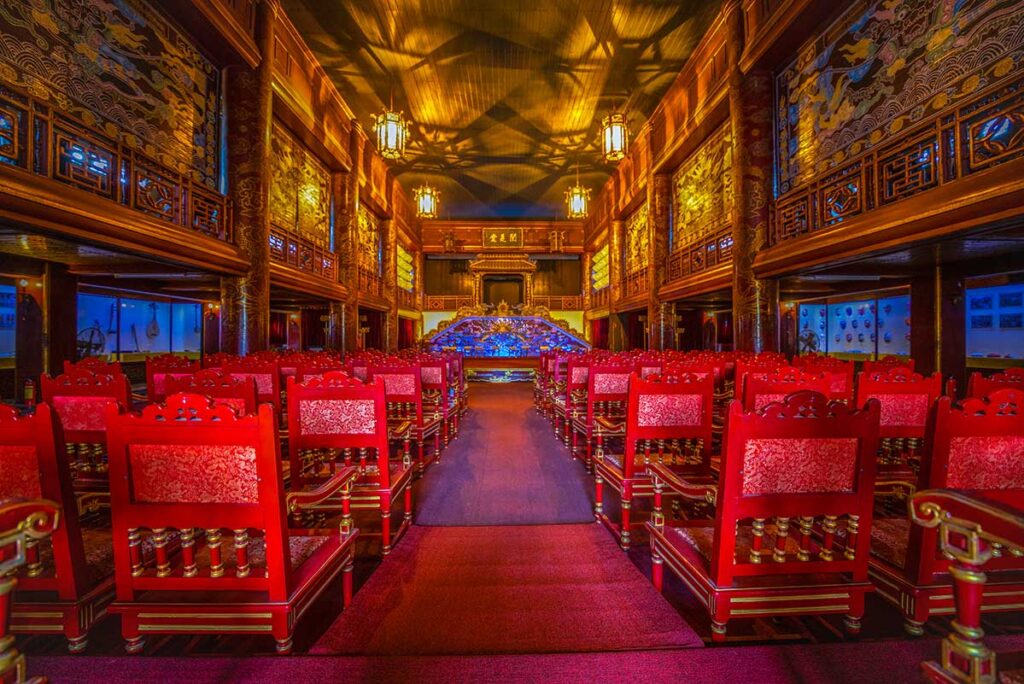
Inside, the layout follows traditional court theatre arrangements. The square stage sits at the centre, with royal seating directly opposite and flanked by positions for mandarins and foreign envoys. Bamboo curtains once shielded the empress and royal consorts from public view, and the lacquered wooden columns are richly gilded. The ceiling features symbolic art, including the sun, moon, and stars, representing the universe.
3. Small exhibition
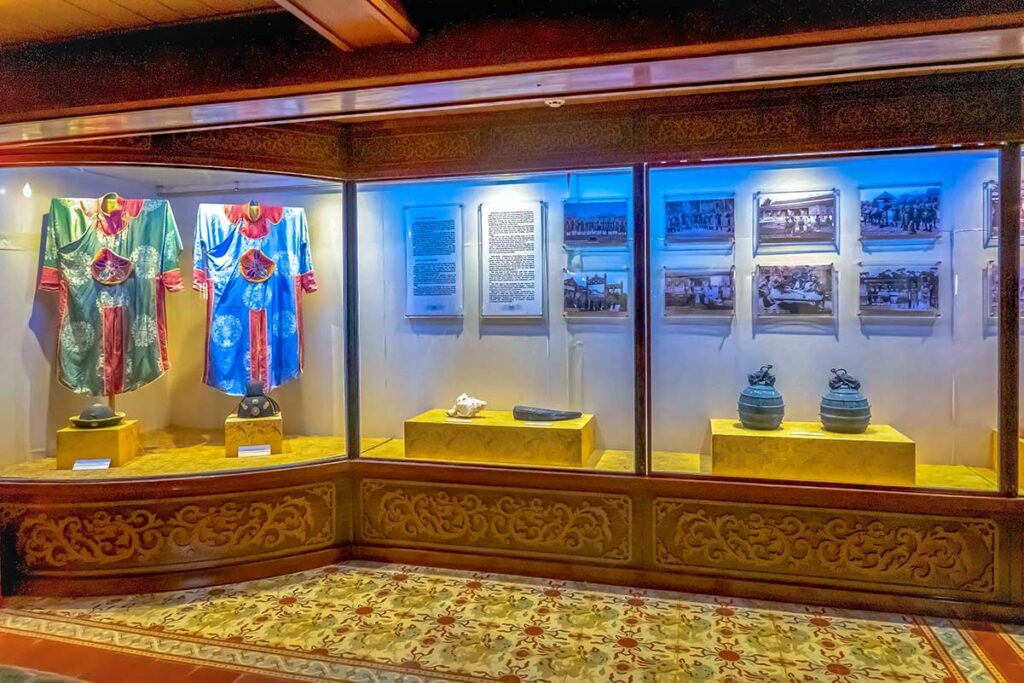
Away from the stage, on both sides of the ground floor houses a modest exhibition. Costumes, masks, musical instruments, and other artefacts give insight into Hue’s royal performing arts. Informative displays help visitors understand the craftsmanship and symbolism behind each item.
4. Performance space
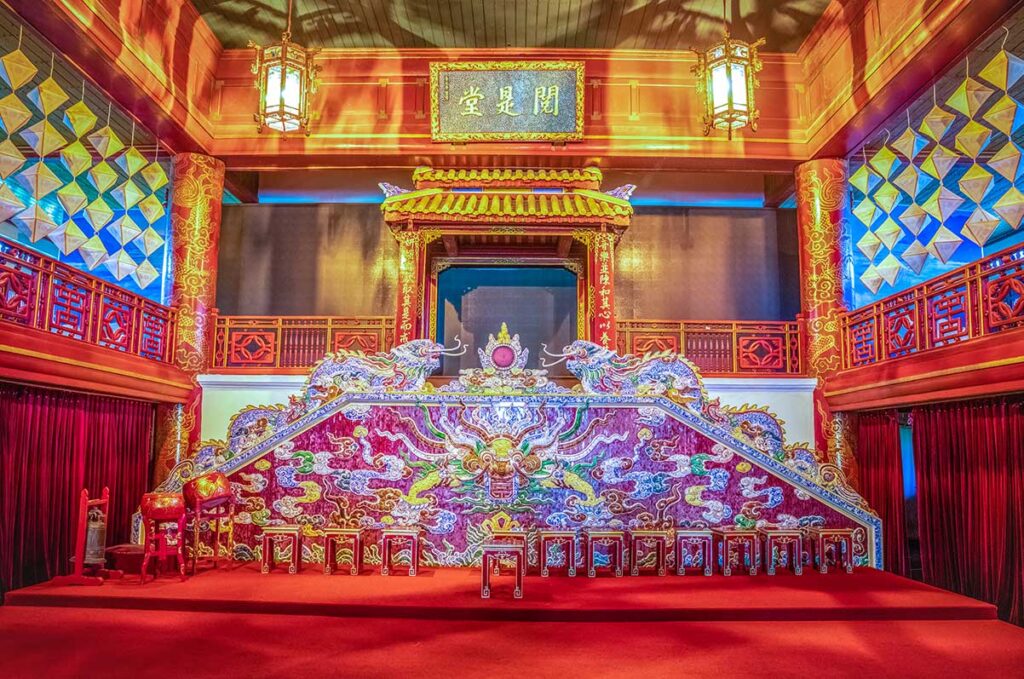
The restored performance hall recreates the atmosphere of an authentic court theatre. Seating is arranged to echo the historical hierarchy, while lighting and acoustics are designed to complement traditional music and dance. Even without a live show, the space offers a strong sense of the theatre’s ceremonial past.
Visiting a show inside the Royal Theatre
Show schedule
Live performances are usually held twice daily, from 10:00 to 10:35 in the morning and 15:00 to 15:35 in the afternoon. It’s best to arrive at least 10–15 minutes early to get settled and enjoy the atmosphere before the show begins.
Tickets
Entry to the Imperial City is required to access the theatre, but the performance itself needs a separate ticket. The price is around 300,000 VND per person, and shows only take place if at least 10 tickets are sold. It’s worth checking at the ticket desk or with Imperial City staff earlier in the day to confirm whether a performance will run.
Performance content
Each show offers a mix of Hue’s traditional royal arts. The programme often includes Nha Nhac (Hue Royal Court Music), graceful royal dances, and short excerpts from Tuong (classical opera). Costumes are vibrant and richly detailed, and the music is performed with traditional instruments, creating an authentic courtly experience.
Is it worth it?
The experience is unique in Vietnam, but opinions vary. Some visitors find it a highlight for its artistry and cultural depth, while others feel the short 35-minute length doesn’t justify the additional ticket price—especially if they’ve seen similar performances elsewhere. If you have a strong interest in traditional Vietnamese music and dance, it’s a rare opportunity to experience them in their historic setting; otherwise, the theatre can still be appreciated for its architecture and small exhibition without attending a show.
Visiting tips and what’s nearby
Imperial City ticketing
Access to the Hue Royal Theatre is included with a general Imperial City ticket, which costs 200,000 VND for adults and 40,000 VND for children aged 7–12. The ticket is valid for the day and allows entry to all sites within the Imperial City complex. Performances at the theatre require a separate ticket.
Tip: Our full-day Hue tour includes the Imperial City, with a local guide and convenient transfers:
Hue Historical City Tour
- Highlights: Hue Imperial City, royal tombs, Perfume River cruise, Dong Ba Market.
- Options: Small-group tour or private tour
Best time to visit
Morning visits offer softer light for photography and generally cooler temperatures. If you plan to attend a show, it’s best to coordinate your exploration of the Imperial City around the 10:00 or 15:00 performance times to avoid doubling back. Early arrival can also help you avoid the busiest tour group periods.
Nearby sights
The theatre is within walking distance of several other notable sites in the Forbidden Purple City and Imperial City:
- Thai Binh Pavilion – The emperor’s private reading room with ornate ceramic inlays.
- Dien Tho Palace – Residence of the Queen Mother, with elegant architecture and gardens.
- To Mieu Temple Complex – Dedicated to the Nguyen emperors, featuring impressive altars.
- Kien Trung Palace – A blend of Vietnamese and European design, recently reconstructed.
Time needed
For a full Imperial City visit, allow at least 2.5–3 hours, more if you plan to attend a performance. The theatre itself takes about 20–30 minutes to explore without a show, and around one hour if you stay for a performance and look through the exhibition afterward.
